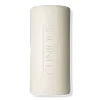What's inside
What's inside
 Key Ingredients
Key Ingredients

 Benefits
Benefits

 Concerns
Concerns

 Ingredients Side-by-side
Ingredients Side-by-side

Salicylic Acid 1.8%
MaskingSodium Palmate
CleansingSodium Palm Kernelate
CleansingWater
Skin ConditioningGlycerin
HumectantSodium Laureth Sulfate
CleansingSodium Hydroxide
BufferingTitanium Dioxide
Cosmetic ColorantGlycereth-26
HumectantTetrasodium EDTA
Sodium Bicarbonate
AbrasiveGlycolic Acid
BufferingPrunus Persica Fruit Extract
AbrasiveParaffinum Liquidum
EmollientStearic Acid
CleansingGlyceryl Stearate
EmollientCetyl Alcohol
EmollientSalix Nigra Bark Extract
Skin ProtectingSodium Chloride
MaskingDisodium EDTA
Citric Acid
BufferingTriethanolamine
BufferingOpuntia Vulgaris Extract
Skin ConditioningSucrose
HumectantPentasodium Pentetate
Salicylic Acid 1.8%, Sodium Palmate, Sodium Palm Kernelate, Water, Glycerin, Sodium Laureth Sulfate, Sodium Hydroxide, Titanium Dioxide, Glycereth-26, Tetrasodium EDTA, Sodium Bicarbonate, Glycolic Acid, Prunus Persica Fruit Extract, Paraffinum Liquidum, Stearic Acid, Glyceryl Stearate, Cetyl Alcohol, Salix Nigra Bark Extract, Sodium Chloride, Disodium EDTA, Citric Acid, Triethanolamine, Opuntia Vulgaris Extract, Sucrose, Pentasodium Pentetate
Sodium Palmate
CleansingSodium Cocoate
CleansingWater
Skin ConditioningPalmitic Acid
EmollientCocamidopropyl Dimethylamine
EmulsifyingGlyceryl Stearate
EmollientZea Mays Starch
AbsorbentHydrolyzed Corn Starch
HumectantGlycerin
HumectantCaffeine
Skin ConditioningZinc PCA
HumectantPPG-26/Dimer Dilinoleate Copolymer
HumectantPolyquaternium-67
Hydrolyzed Corn Starch Octenylsuccinate
AbsorbentSodium Chloride
MaskingTetrasodium EDTA
Tetrasodium Etidronate
Emulsion StabilisingChlorphenesin
AntimicrobialCI 77891
Cosmetic ColorantSodium Palmate, Sodium Cocoate, Water, Palmitic Acid, Cocamidopropyl Dimethylamine, Glyceryl Stearate, Zea Mays Starch, Hydrolyzed Corn Starch, Glycerin, Caffeine, Zinc PCA, PPG-26/Dimer Dilinoleate Copolymer, Polyquaternium-67, Hydrolyzed Corn Starch Octenylsuccinate, Sodium Chloride, Tetrasodium EDTA, Tetrasodium Etidronate, Chlorphenesin, CI 77891
 Reviews
Reviews

Ingredients Explained
These ingredients are found in both products.
Ingredients higher up in an ingredient list are typically present in a larger amount.
Glycerin is already naturally found in your skin. It helps moisturize and protect your skin.
A study from 2016 found glycerin to be more effective as a humectant than AHAs and hyaluronic acid.
As a humectant, it helps the skin stay hydrated by pulling moisture to your skin. The low molecular weight of glycerin allows it to pull moisture into the deeper layers of your skin.
Hydrated skin improves your skin barrier; Your skin barrier helps protect against irritants and bacteria.
Glycerin has also been found to have antimicrobial and antiviral properties. Due to these properties, glycerin is often used in wound and burn treatments.
In cosmetics, glycerin is usually derived from plants such as soybean or palm. However, it can also be sourced from animals, such as tallow or animal fat.
This ingredient is organic, colorless, odorless, and non-toxic.
Glycerin is the name for this ingredient in American English. British English uses Glycerol/Glycerine.
Learn more about GlycerinGlyceryl Stearate is a mix of glycerin and stearic acid.
It is used to stabilize the mixing of water and oil ingredients. By preventing these ingredients from separating, it can help elongate shelf life. It can also help thicken the product's texture.
As an emollient, it helps soften skin and supports barrier-replenishing ingredients.
In cosmetics, Glyceryl Stearate is often made from vegetable oils or synthetically produced.
This ingredient may not be fungal-acne safe
Fun fact: The human body also creates Glyceryl Stearate naturally.
Learn more about Glyceryl StearateChances are, you eat sodium chloride every day. Sodium Chloride is also known as table salt.
This ingredient has many purposes in skincare: thickener, emulsifier, and exfoliator.
You'll most likely find this ingredient in cleansers where it is used to create a gel-like texture. As an emulsifier, it also prevents ingredients from separating.
There is much debate on whether this ingredient is comedogenic. The short answer - comedogenic ratings don't tell the whole story. Learn more about comegodenic ratings here.
The concensus about this ingredient causing acne seems to be divided. Research is needed to understand if this ingredient does cause acne.
Scrubs may use salt as the primary exfoliating ingredient.
Learn more about Sodium ChlorideSodium Palmate is a surfactant and used to saponify fatty acids. It can be derived from palm oil or synthetically created.
As a surfactant, it helps lift dirt and oil off the skin to be cleansed.
Sodium Palmate is also used during the soap-making process to saponify fatty acids. This helps soap creates bubbles without leaving residue on the skin.
This ingredient is sometimes called saponified palm oil.
Learn more about Sodium PalmateTetrasodium EDTA is the salt formed from neutralizing ethylenediamine tetraacetic acid with sodium hydroxide. It is a chelating agent and used to prevent metal ions from binding to other ingredients. This helps keep the product and ingredients stable.
Tetrasodium EDTA comes as a white solid and is soluble in water.
Water. It's the most common cosmetic ingredient of all. You'll usually see it at the top of ingredient lists, meaning that it makes up the largest part of the product.
So why is it so popular? Water most often acts as a solvent - this means that it helps dissolve other ingredients into the formulation.
You'll also recognize water as that liquid we all need to stay alive. If you see this, drink a glass of water. Stay hydrated!
Learn more about Water